Content outlines are important because they are the foundation of good SEO-optimized content.
They can help you organize content ideas, develop a solid structure, and ensure that your content is conveyed in a clear and concise manner.
A content outline emphasizes the most important points, main ideas, and overall structure of a written piece. As a result, it is valuable in creating written content.
In this article, we will provide helpful tips and examples to assist you in creating a good content outline.
Table of Contents
Understanding the Importance of a Content Outline
A good content outline can help you communicate clearly with your writers, save time, and lay the groundwork for a well-organized and interesting piece of writing.
It’s a resource that ensures the writing is clear and consistent throughout the process.
A content outline does not exist on its own. Instead, it is an important part of the content brief.
The brief provides context, but the outline helps to bring clarity and organization, promoting good cooperation between you and your writers.
Below is an interesting discussion on Linkedin about the difference between a content outline and a content brief.

In the thruuu definition, we consider a content outline, the structural part of the brief defining the layout of the article and headings structure.
Tips for Creating Your Content Outline
Creating a content outline is an important stage in any writing process.
It’s like a road map that keeps you organized and on track with your content goals.
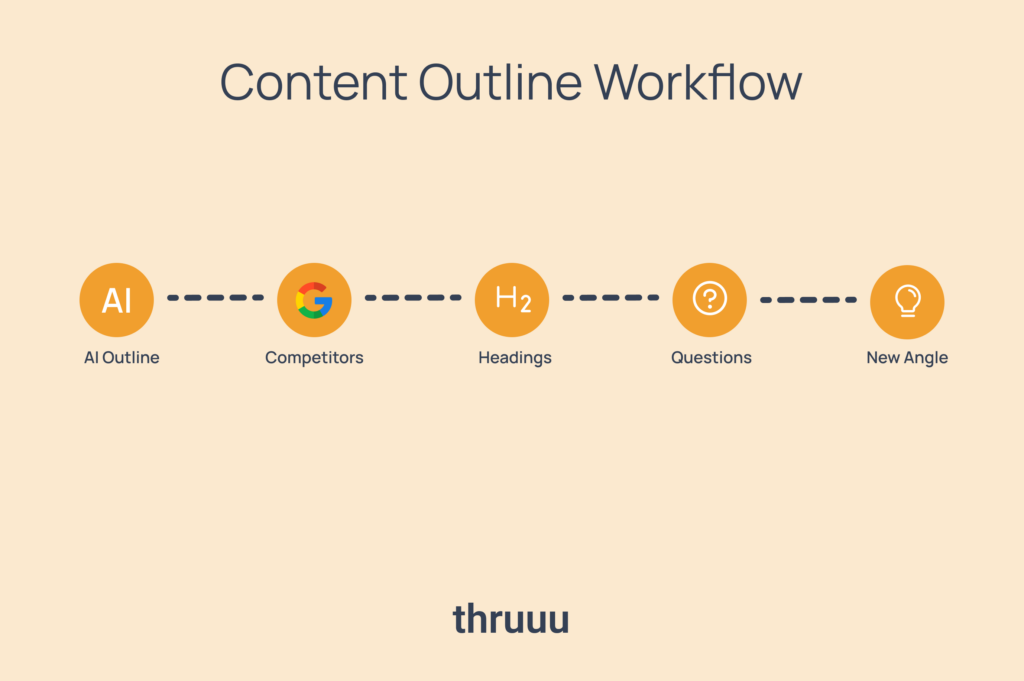
Here are some tips on how to make a good content outline:
Define the Goals and Objectives of Your Content
Begin your content creation journey by clearly stating your content’s goals and objectives.
You need to have a clear destination before you set off.
These goals and objectives act as your guideposts, telling you where you want to go with your writing.
You can consider a few things while in the process: Do you want to inform your readers, persuade them, or encourage them to take action?
Defining these goals helps your writing stay on track and makes sure it connects with your intended audience.
Establishing your goals and objectives gives your content a purpose and guides your writers.
As a result, this increases the likelihood of creating content that effectively communicates your message and achieves the desired outcomes.
Conduct Keyword Research and Identify Relevant Keywords
Start by discovering the words and phrases your audience uses when searching.
To help with this, you can use keyword research tools like Semrush, Ahrefs, or thruuu to explore popular and relevant terms related to your topic.
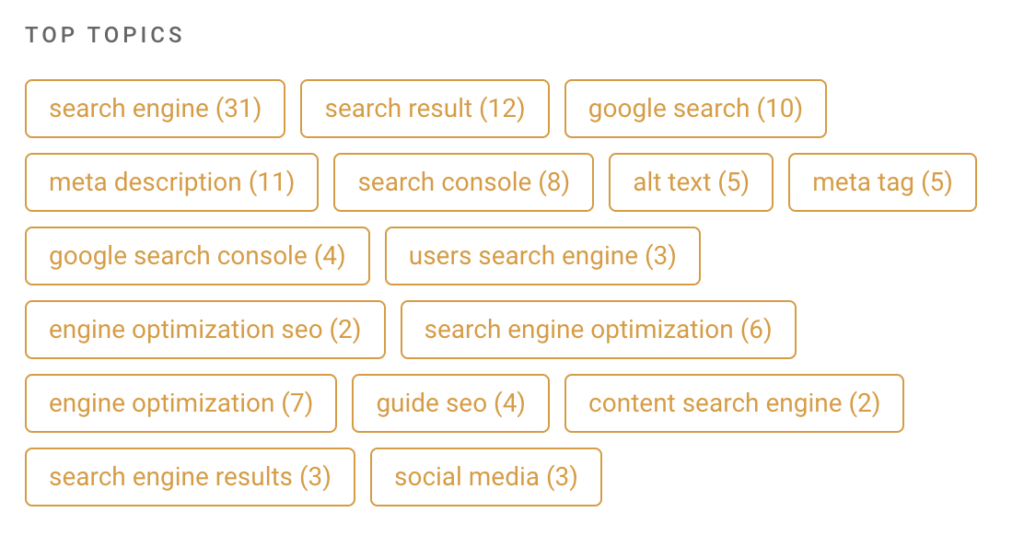
Integrating relevant keywords seamlessly into your content is like speaking the same language as your audience, making your content informative and easily discoverable.
Explore Competitors’ Content Strategies
Exploring your competitors’ content strategies is important when creating a content outline.
It informs you about what has worked for others in your industry, helps you identify content gaps, and shapes your own strategy.
As highlighted by Ashley Segura, Head of Global Marketing at TopHatRank, it is also important to identify patterns in the top 10 ranking articles, as well as how they are structured in terms of paragraphs, bullet points, images, and so on.

However, note that the goal is not copying but understanding your competitors’ content strategy to help you improve your content.
This will ensure that your outline follows established strategies while also providing an interesting and unique perspective for your audience.
With the thruuu SERP Analysis tool, you can explore the most frequent headings for the first 100 articles on Google Search.
This tool helps you explore your competitor’s content strategies and the common topic discussed within each article, but also to identify low-hanging fruit and topics that could be developed further.

Identify Opportunities for Unique Content
Discover unexplored territories within your niche, including areas that your competitors may have missed.
This is where your unique voice finds its stage.
Identifying opportunities for creating unique content sets your work apart and allows you to offer value to your audience.
Unique content is the peak of content writing. Not only does it capture attention, but it also helps establish you as a thought leader.
To enhance your writing, explore the ongoing conversations in your niche and integrate your content with the brilliance of original ideas.
Crafting an Attention-Grabbing Title and H1
Crafting a compelling title is your content’s first impression.
It is the headline that invites your readers to explore further. Ensure it contains your target keyword because this is what signals to search engines.
While your Meta Title and H1 can differ slightly, they should both smoothly introduce the following content.
Although they share a common goal, the slight difference between them can add layers of meaning.
The Meta Title, which is visible to search engines, needs to be concise and keyword-rich, enticing algorithms to categorize your content effectively.
On the other hand, the H1, the primary header visible to readers, invites them to engage with your content.
💡Example Titles
Unveiling the Secrets for Crafting Content That Captivates and Converts
Beyond Keywords: The Art of Creating Titles That Resonate
Your SEO Success to Mastering Meta Titles and H1s
The thruuu content brief generator helps in creating a title for your article. The tool analyzes the top-performing titles and suggests ideas for your content.
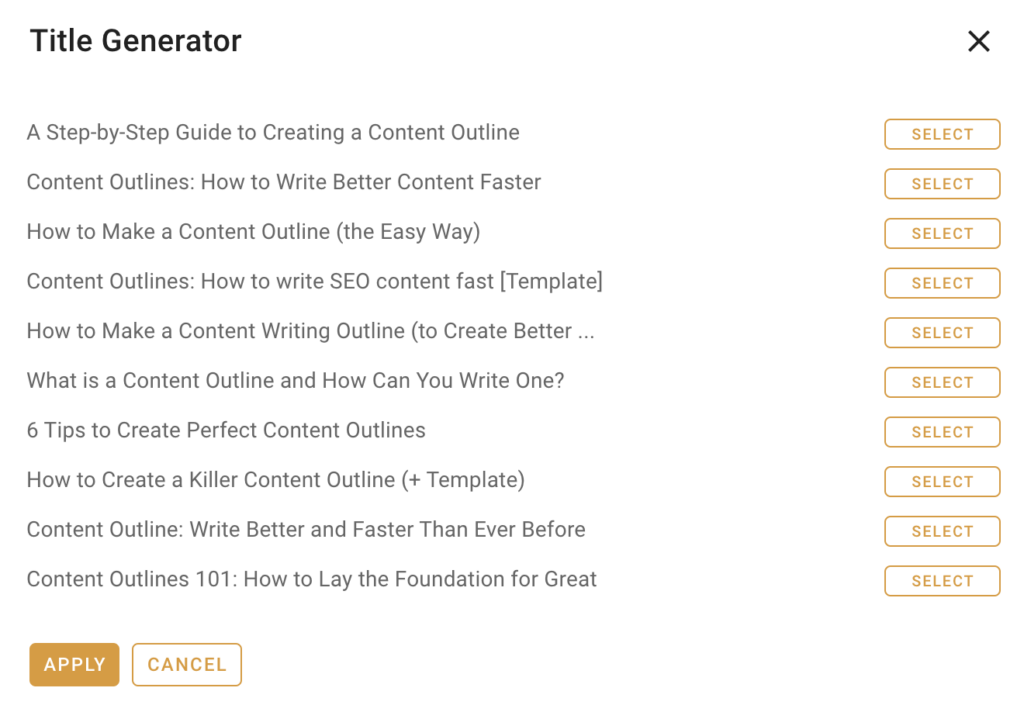
Structure Your Content with Actionable Subheadings and Subsections
Creating high-quality content requires the skillful use of actionable subheadings and subsections.
These elements act as a guide for your readers, helping them navigate through your content and find the information they need.
Including subheadings in your content can greatly improve its structure, making it easier to read and understand.
They divide your content into smaller sections and help create a smooth and seamless flow, ensuring that each idea transitions naturally into the next.
Note the comment from Vishal Dave, Content Writer at Meetanshi. It is crucial to understand what the reader wants and get to the point as soon as possible in your copy.

Include Main Keywords and Secondary Keywords in the Headings
Headings are more than just labels; they help search engines find your content.
When you strategically use main and secondary keywords in your headings, you’re literally making a map for search engines.
In addition to the traditional SEO approach, using keywords within headings can also help guide readers to the main points of your content.
Main keywords are important because they give a general idea and summarize the main points of your topic.
On the other hand, secondary keywords are more specific and help to provide a better understanding of the subject.
For instance, if you write a blog post about “growing tomatoes,” avoid creating an outline structure like this one:
- Introduction
- Choosing
- Sowing
- Planting
- Harvesting
- Storing
- Conclusion
But rather include keywords in each heading:
- Get started with growing your tomatoes
- Choosing tomato varieties
- Sowing tomato seeds or transplants
- Steps to plant tomatoes
- Best practice to harvest tomatoes
- Storing tomatoes for preservation
- Tomato gardening summary
Include Long Tail Keywords in the Headings
Long tail keywords are highly detailed and specific phrases designed to cater to specific search queries.
Consider incorporating them into your headings to achieve a more polished and focused approach.
To continue our example, we could add headings including long tails queries such as:
- How to harvest tomatoes when you are a beginner
- How to grow <a variety name> of tomatoes
Using long-tail keywords can enhance the visibility of your content and make it more relevant to users’ specific search queries.
These keywords provide a more accurate description of the subject matter that users are currently looking for.
Include Questions and Answers in the Outline
Engage your audience with a question and answer structure within your headings.
This stimulates curiosity and positions your content for featured snippets, enriching the user experience.
It feels as if you’re engaging in a conversation with your readers, anticipating and addressing their questions before they even come up.
One of the strengths of this is its clarity. Using the right questions in your outline can help readers quickly determine if your content will address their search query effectively.
Also, as noted by Trevor Stolber, Digital Marketing Consultant at STOLBER, by leveraging questions and answers, you increase your chances of being featured in PAA or Featured Snippet in the SERP.

Craft an Introduction that Hooks Your Audience
Your introduction sets the tone for the entire journey.
In your outline, provide additional information to guide your writers as they write the introduction, offering them insights into your content’s overall theme.
Consider the user’s intent and existing knowledge level, ensuring your introduction aligns with their needs.
Gauging your readers’ knowledge level can help you tailor your introduction to align with their existing understanding.
By doing this, the relevance rating of your content is ultimately enhanced since it helps to fill in any knowledge gaps right from the start.
Also follow Ben Goodey, found of How the F*ck Agency (and subscribe to his newsletter) as he shared great tips about writing great introductions:
- Offer reassurance
- Hook attention
- Improve accessibility
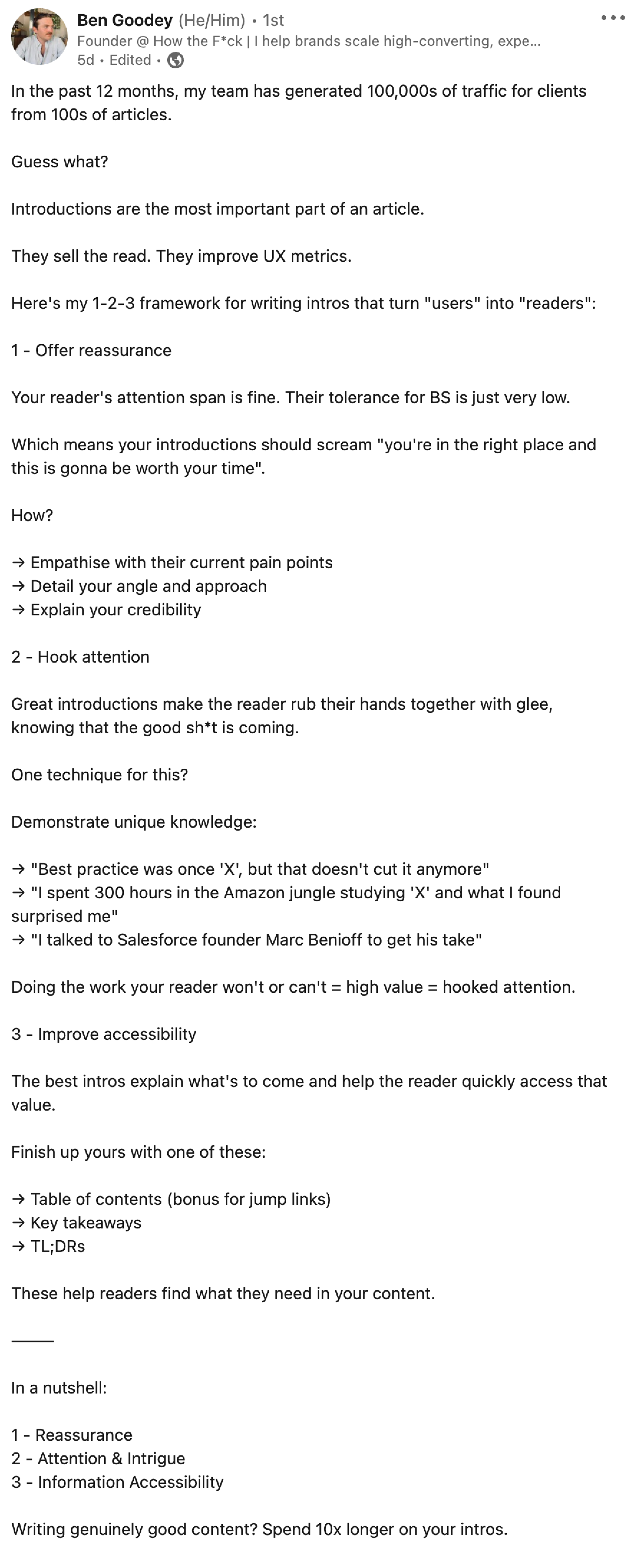
Include a FAQ Section
Frequently Asked Questions (FAQs) serve as a versatile SEO practice.
They are a powerful content technique that relies on exchanging questions and answers.
FAQs are a great way to provide information and answer various questions.
By placing it at the end, you can keep your main content concise and focused while also providing an extra layer of information.
A good practice is to add the questions in Heading 2 or Heading 3 and then directly answer the question.
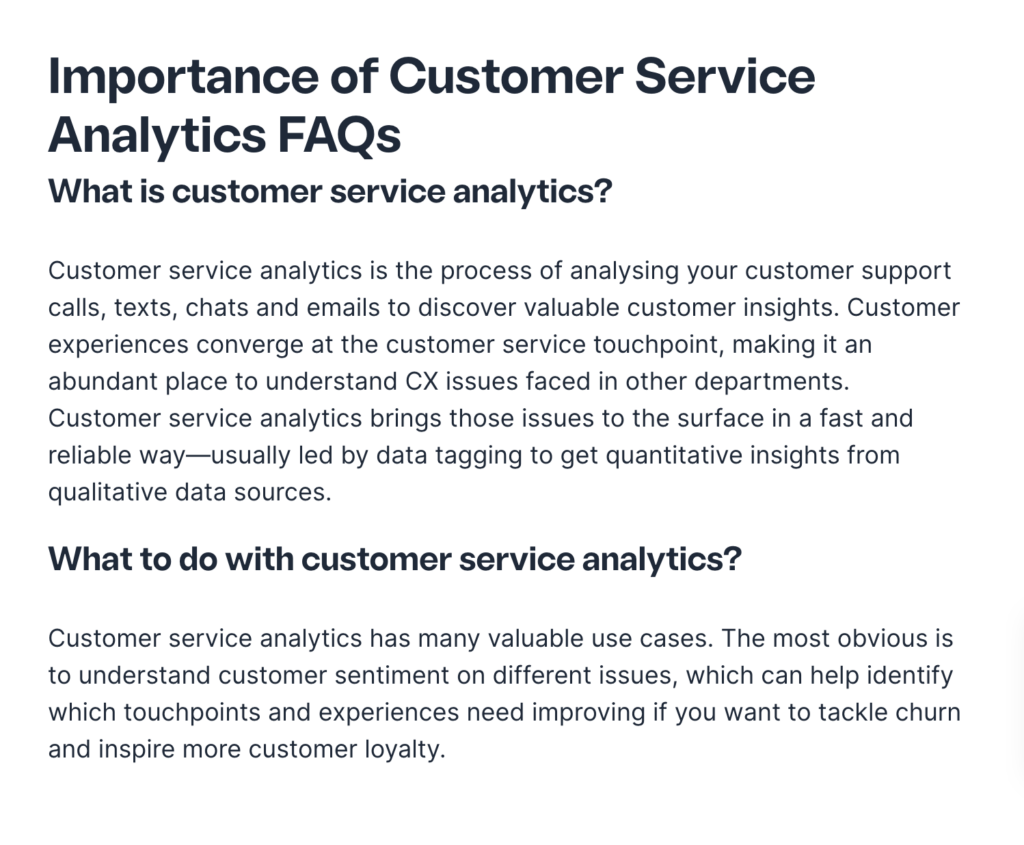
🚀 Pro Tip: Check our guide about creating FAQ Blog Posts.
Include Call-to-Action
Guide your audience to the next step with strategic calls-to-action (CTAs).
Put them within your outline, giving your writers a cue to prompt readers to explore related content, subscribe, or take any desired action.
CTAs are essential in gently encouraging readers to take action, turning them from passive observers into engaged participants.
Utilizing A Content Outline Generator
Explore the efficiency of the thruuu content outline generator for creating your content brief.
Our tool streamlines the outlining process, making content creation more seamless and structured.
Our outline editor offers great features such as:
- Analysis of real-time data from Google Search
- User-friendly interface
- Explore the heading structure of your competitors
- Click on a heading to add it to your brief
- Generated AI outline and headings structure based on your competitor
- Explore the most frequent headings, questions, and PAA and add them to your outline
- Create a specific article format to keep a consistent structure across your article
Watch the video below to see the content outline tool in action.
Content Outline Examples and Templates
There are several types of content outline and SEO blog templates that you could follow, but we wanted to list the most common ones.
Listicle Content Outline
A listicle content outline is a structured format that presents information as a list, making it easily digestible and engaging for readers.
This type of outline organizes content into distinct, numbered, or bulleted points, each providing a specific idea, tip, or information.
Listicles are popular for their readability, providing a clear and concise format that appeals to audiences seeking quick, actionable insights.
Heading Structure for a Listicle Content Outline
- Introduction: Briefly introduce the topic and set the stage for what the listicle will cover.
- Point 1: Concisely presents the first key point or idea.
- Point 2: Move on to the second point, maintaining a clear and organized flow.
- Point 3: Continue the list with the third significant point.
- Point 4: Progress through the list with the fourth point.
- Point 5: Conclude the list with the fifth and final point.
- Conclusion: Summarize key takeaways or provide a concluding thought to wrap up the listicle.
Ultimate Guide Outline
An ultimate guide content outline is a comprehensive and in-depth format designed to provide readers with extensive knowledge on a particular topic.
Unlike shorter formats, an ultimate guide aims to cover every aspect of a subject, serving as a valuable resource for in-depth understanding.
This type of outline typically includes detailed explanations, examples, and actionable insights.
Heading Structure for an Ultimate Guide outline
For example, if your guide is a focused ultimate guide for beginners on baking sourdough bread, your heading structure might look something like this:
I. Introduction to Sourdough Baking:
- What is sourdough?
- Benefits of sourdough bread
- Equipment and ingredients you need
II. Starting Your Sourdough Starter:
- Feeding and maintaining your starter
- Troubleshooting common starter issues
III. Baking your First Sourdough Loaf:
- Basic sourdough recipe
- Step-by-step instructions with tips
- Troubleshooting common baking problems
IV. Sourdough Beyond the Basics:
- Experimenting with different flours and hydration levels
- Advanced shaping techniques
- Creative topping and filling ideas
How To Guide Outline
A how-to guide content outline is a structured format that walks readers through a step-by-step process to achieve a specific goal or complete a task.
This type of outline is practical, providing clear instructions and actionable advice for readers.
Heading structure for a How-To guide outline
Here’s an example of a how-to guide content outline titled “How to Change a Flat Tire.”
I. Introduction
- Title: How to Change a Flat Tire Like a Pro
- Overview: Learn how to safely and efficiently change a flat tire in under 30 minutes, even if you’ve never done it before.
- Target Audience: Beginner drivers, those unfamiliar with car maintenance, or anyone who wants to be prepared for roadside emergencies.
II. Essential Information
Key Terms: Flat tire, spare tire, jack, lug wrench, tire iron, torque wrench
Materials Needed:
- Spare tire
- Jack
- A lug wrench or tire iron
- Wheel chocks (optional)
- Gloves (optional)
Safety Precautions:
- Park on a level, stable surface.
- Turn on hazard lights and set the parking brake.
- Use wheel chocks to prevent the vehicle from rolling.
- Never work under a car supported only by a jack.
III. Step-by-Step Instructions
- Secure the vehicle and locate tools.
- Loosen lug nuts before raising the car.
- Position the jack and lift the vehicle.
- Remove lug nuts and flat tire.
- Mount the spare tire.
- Hand-tighten lug nuts.
- Lower the vehicle and fully tighten the lug nuts.
- Stow tools and check tire pressure.
IV. Additional Tips and Tricks
- Practice changing a tire in a safe environment before an emergency.
- Check tire pressure regularly and replace worn tires.
- Consider carrying a tire inflator kit for quick repairs.
- Consult your vehicle’s owner’s manual for specific instructions.
V. Conclusion
Final Thoughts
We have provided valuable tips to help you create content.
These tips cover everything from understanding the significance of a strong outline to implementing specific strategies like setting goals, conducting keyword research, and analyzing competitors’ content.
Now that you know the importance of content outline.
You can take a closer look at the different types of outlines we introduced you to using the thruuu Content Optimization Solution today.
This will help you enhance your content creation process right away.
Create Better Content Briefs
Our end-to-end content optimization solution empowers your team to crack the Google algorithm, craft exceptional content, and achieve remarkable organic search results.
